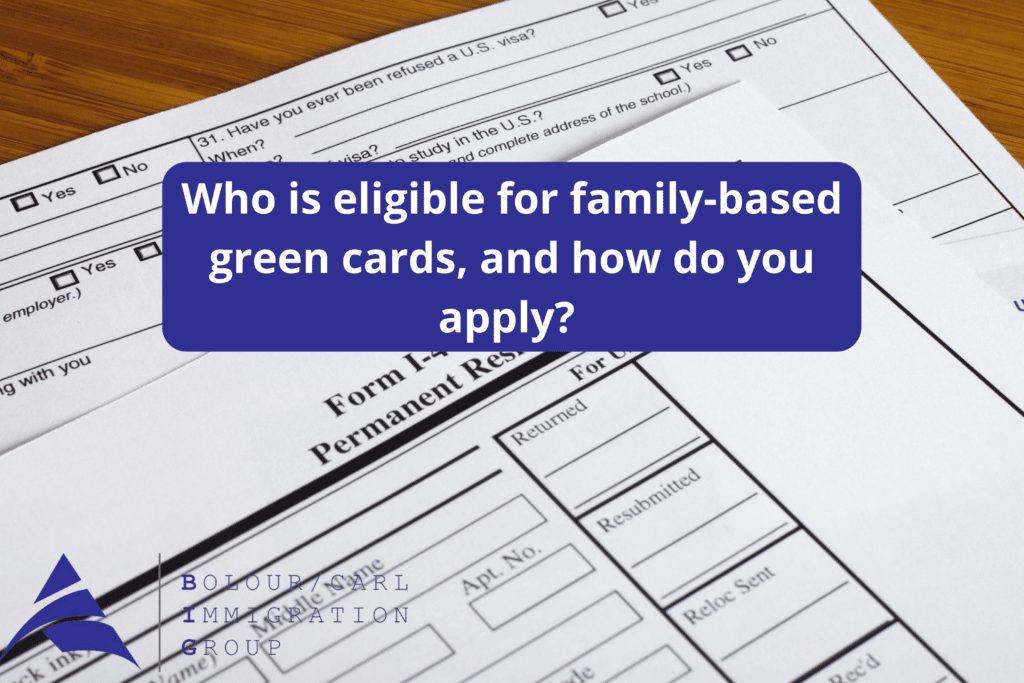
If you are a family member of a U.S. citizen or permanent resident, you may be able to obtain a green card based on that family relationship. Below are the different categories of family based green cards and the procedures for applying, which vary depending on whether you are inside or outside the United States.
Immediate Relatives
There is an unlimited number of green cards available for immediate relatives of U.S. citizens every year. Immediate relatives include the spouse and unmarried children under age 21 of a U.S. citizen, as well as a U.S. citizen’s parents (if the citizen is over 21 years of age).
Family Preference
The family preference visa category applies to a broader range of family members of U.S. citizens and, in some cases, U.S. permanent residents. The number of green cards that are processed in this category is limited each year, with certain relationships receiving greater preference.
F1 First Preference
F1 or first preference visas are reserved for unmarried sons and daughters of U.S. citizens who are age 21 and over (and therefore cannot qualify as an immediate relative).
F2 Second Preference
The second preference category is broken out into F2A and F2B. F2A visas are for spouses and children (unmarried under age 21) of U.S. permanent residents, while F2B is for unmarried adult sons and daughters (age 21 and older) of U.S. permanent residents.
F3 Third Preference
Next on the hierarchy are married sons and daughters of U.S. citizens.
F4 Fourth Preference
Finally, the brothers and sisters of adult U.S. citizens can apply under the F4 category.
Application Process
If you are applying for an immediate relative or family preference green card, your U.S. citizen or permanent resident family member must file Form I-130, Petition for Alien Relative, with United States Citizenship and Immigration Services (USCIS) on your behalf.
If you are already living in the United States under a different status, you can apply to adjust your status using Form I-485, Application to Register Permanent Residence or Adjust Status. You will also have to submit supporting documentation, including Form I-864, Affidavit of Support, which your petitioner will have to fill out and sign, accepting financial responsibility for you.
As long as there is a visa available for you, you can file to adjust your status at the same time your family member files Form I-130; alternately, you can file while Form 1-130 is pending or after it has been approved. If a visa is not available, you will have to wait to file Form I-485.
If you are living outside the United States, you must apply for your visa through a U.S. Embassy or Consulate in your country. You cannot do this until USCIS approves the I-130 petition and transfers your case to the National Visa Center for processing. After you have paid your fees, you must complete Form DS-260, Application for Immigrant Visa and Alien Registration online and submit supporting documentation. Your petitioner will have to submit Form I-864, Affidavit of Support, accepting financial responsibility for you. You must attend your interview on the scheduled time and date, at which point a Consular official will determine if you are eligible to obtain a green card.
Petition Number
Although green cards for immediate relatives are always available, family preference green cards are typically limited to 226,000 total visas per year. This tally is further divided into several sub-categories, based on the preference category and the applicant’s country of origin. No single country can account for more than 7 percent of the green cards in a particular category. If demand for your subcategory outstrips supply, you will be placed in a visa queue. You will be assigned a priority date, which corresponds to the date the I-130 petition was property filed on your behalf.
The Department of State’s Visa Bulletin, which is updated every month, shows which green card applications can move forward based on the priority date. You can use the Visa Bulletin to estimate your wait time by monitoring how quickly you are moving up in line. Depending on your preference category and your country, the wait time may be several months or several years.
If you would like to speak to a family-based green card lawyer, contact Bolour/Carl Immigration Group at 323-857-0034 or [email protected].




